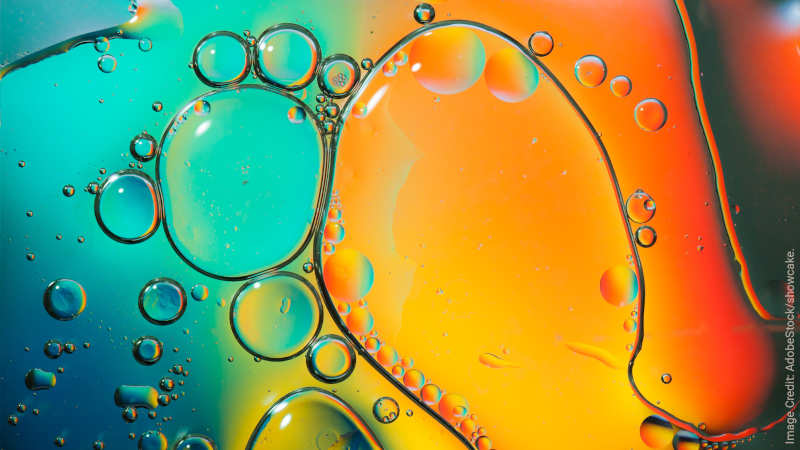STRUCTURES Blog > Posts > How Do the Tails of Jellyfish Galaxies Form?
How Do the Tails of Jellyfish Galaxies Form?

What Are Jellyfish Galaxies?
Galaxies, like our own Milky Way, come in all shapes, sizes, and colours, and exploring their evolution is key to understanding how our Universe formed. Since the first images from the Hubble Space Telescope almost thirty years ago, and especially with the advent of the Sloan Digital Sky Survey in 2000, we have been imaging thousands to millions of galaxies across the Universe. One particular type of galaxy has become popular in the past few years as only a few hundred have ever been observed: jellyfish galaxies. The stars in these galaxies look relatively normal, but the hydrogen gas forms long, asymmetric tails (above right), resembling the tendrils of jellyfish. While we can explain the vast majority of normal galaxies, these seemingly rare jellyfish galaxies provide a new testing ground for our models of galaxy formation and evolution.
Our first hint about the formation of jellyfish galaxies has little to do with the jellyfish themselves; rather, we notice that these galaxies live in the vicinity of larger, more massive galaxies. That is, maybe the galactic environment plays a key role in developing the gaseous tails. In fact, we have known for nearly fifty years that galaxies in denser environments – local regions with many galaxies – tend to have different shapes and colours than their more isolated counterparts. That is because as galaxies interact, the fundamental properties of their structure, stars, and gas can change dramatically. We have long since speculated that ram pressure – the same pressure you feel when extending your hand outside of a moving car – is the culprit disturbing these galaxies. And just as the air in our atmosphere pushes your hand backwards, the gas around these jellyfish pushes the jellyfish gas backwards (see Deep Dive box for more details), leading to the tails of gas trailing from their main luminous bodies. Not only do they look intriguing, like in the images above, but jellyfish galaxies are also interesting from a scientific perspective because they are an extreme example of the environment at play, namely by exerting ram pressure on the infalling galaxy.

Deep Dive: Ram Pressure Stripping
Ram pressure is the pressure exerted on a body moving through a fluid, where there is a motion of the body relative to the fluid. In the case of jellyfish galaxies, the jellyfish travel through the gas that surrounds their more massive companions, called the circumgalactic medium (CGM). The strength of this pressure depends on both the density $\rho_{\rm CGM}$ of the fluid, the CGM, and the square of the relative velocity $v_{\rm rel}^2$ between the jellyfish and the CGM. In order to remove some of the jellyfish gas, the ram pressure must be stronger than gravity trying to keep the gas in the galaxy. As the galaxy’s stars provide a majority of the gravitational force, we can write the strength of the gravitational force $F_g = F_g(M_\star)$ as a function of the galaxy’s stellar mass $M_\star$. Thereby, to remove a parcel of jellyfish gas, the ram pressure must be
$\begin{equation}\rho_{\rm CGM} \cdot v_{\rm rel}^2 > \frac{F_g(M_\star) }{\text{unit area}} \end{equation}$
For a given jellyfish galaxy with mass $M_\star$, the ram pressure becomes stronger when the CGM density $\rho_{\rm CGM}$ and/or the relative velocity $v_{\rm vel}$ increase. It turns out that both of these tend to increase as the environment becomes denser, typically parameterized by the total mass of the host halo encompassing all neighbours and centred on the biggest and brightest nearby galaxy. We tend to see the highest number and most spectacular jellyfish in the largest groups and clusters of galaxies in the Universe! Moreover, as jellyfish fall towards the centres of their groups or clusters, both $\rho_{\rm CGM}$ and $v_{\rm vel}$ increase, further increasing the ram pressure. And for a given host halo, ram pressure becomes more effective at removing gas from smaller, less massive galaxies with fewer stars (smaller $M_\star$). In summary, ram pressure removes the gas from the galaxies as they fall into galaxy groups and clusters, forming the jellyfish tails, and this pressure becomes stronger for denser environments (more massive hosts), at smaller distances to their hosts, and for smaller jellyfish galaxies.
How Do We Study Jellyfish Galaxies?
Jellyfish galaxies are relatively rare and only a few hundred cases have been found in observations. Observations give us a snapshot of a galaxy at a single point in time, with no way of studying its history or future. Meanwhile, modern cosmological simulations - computer simulations that follow the evolution of a large volume of the Universe - have managed to reproduce galaxy populations that resemble those seen in observations to a great degree of success. By using simulations, we are not affected by the limitations of our observational instruments and thus can find jellyfish galaxies in regimes that are difficult to study with telescopes.
In our research group we use the IllustrisTNG simulation suite to study jellyfish galaxies. The IllustrisTNG simulation follows the evolution of the Universe, from the Big Bang till today, in three representative cubic volumes of varying size, including all the relevant physical processes needed to form galaxies: gravitational forces and the expansion of the Universe, hydrodynamics of the gas and the formation of stars and black holes, including the energy released by exploding stars (supernovae) and supermassive black holes. From the simulations, we have a pool of several hundred thousand satellite galaxies, galaxies orbiting around a more massive host, with which to find and study these interesting objects.
But how does one find a jellyfish galaxy amongst hundreds of thousands of candidates? Due to their distinctive shape, jellyfish galaxies are very easy to identify by eye, but it turned out to be quite difficult to construct an automatic algorithm for identifying the tell-tale gas tails. Since examining such a large number of objects ourselves was not feasible, we decided to ask for help.
To do this, we turned to the Zooniverse website (https://www.zooniverse.org), a citizen-science platform that allows scientists from all disciplines to enlist the help of volunteers (often non-experts) in carrying out identification and analysis tasks in a myriad of projects in astronomy, biology, history, physics, literature and many more. Using citizen scientists to identify structures and classify galaxies has been widely successful since the original Galaxy Zoo project in 2008 (Lintott et al. 2008). We set up our project with a sample of roughly 38,000 galaxy images and sent out a call for action both strange and exciting: “Help us find galaxies that look like jellyfish!” You can check out our project for yourself here!
We asked a simple question for each galaxy image: “Does this galaxy look like a jellyfish?” and required at least 20 classifications from different volunteers for each image to make a decision. To our surprise and delight, the response to our projects was very swift and the ~760,000 classifications needed were completed in ten days! In the second phase, an additional 51,000 galaxy images were classified within two months.
Overall, nearly 6,500 volunteers from all over the world (the project is available in English, German, Italian, and even Hebrew) took part in generating more than 1.8 million(!) classifications. While many volunteers only classified a handful of objects, the average number of classifications per volunteer was 276 images. Several hundreds of dedicated volunteers each classified more than 1,000 images and ~40 very dedicated volunteers each classified more than 5,000 images. A few even classified more than 10,000 each! Since the classifications were carried out by volunteers with varying degrees of experience we devised a way of assessing the quality of the volunteers based on their classification history and in this way improve the identification of jellyfish galaxies by giving more weight to the classifications of more experienced volunteers.
The images shown to the volunteers were generated from a random orientation, to mimic the actual observations. This can naturally affect the way a galaxy appears and can sometimes obscure the gas tails of jellyfish galaxies or create an illusion of gas tails due to additional gas structures in the foreground or background. To test this, for ~8,700 galaxies, we also generated an additional image, in an optimal orientation for identifying gas tails and showed them to the volunteers. In this way, we could also assess what are the effects of image orientation in visually classifying these galaxies.
After the initial classification, our sample contained more than 80,000 galaxies, of which over 5,300 were identified as jellyfish galaxies.



What Have We Learned About Jellyfish Galaxies?
Using the 5,300 galaxies identified by the citizen scientists, we have gained profound insights into the astrophysics governing jellyfish galaxies, which we have presented in three published papers! In the explanation and public data release of the jellyfish data, Zinger et al. (2024) find that the simulated jellyfish tend to be found in more massive hosts, have lower stellar masses, and are found at closer host-centric distances, all of which agree with our expectations from ram pressure stripping (see the Deep Dive box for more details). Thanks to the large sample that probes regions of parameter space (host mass, satellite stellar mass, and host-centric distance), we were able to shed light on the demographics of jellyfish in never before studied regimes, such as jellyfish at large distances from their hosts and around galaxies like our own Milky Way. Moreover, we learned that projection effects play a key role in visually identifying jellyfish galaxies. Satellites moving either into or out of the page, away or towards the reader, are less likely to appear as jellyfish as when they are moving along the page and their tails are clearly visible (see above images). We could be misclassifying up to ~30% of jellyfish galaxies in observations, where we only have one viewing angle.
To further understand the intricacies of the ram pressure stripping affecting these jellyfish galaxies, Rohr et al. (2023) study the evolution of these jellyfish galaxies throughout their lives. They quantified the amount of gas lost due to ram pressure stripping along the jellyfish orbits, finding again that jellyfish in more massive hosts, with lower stellar masses, and at closer distances tended to lose more gas. Simultaneously with this ram pressure stripping, Göller et al. (2023) study the star-formation in both the main bodies and in the tails of these jellyfish galaxies. Importantly, they find that the population of jellyfish do not show elevated star forming activity, as some recent observational studies suggest. However, a majority of jellyfish experience quick bursts of ram-pressure-induced star formation shortly after falling into their hosts, temporarily enhancing their star formation. It remains to be seen why exactly many jellyfish undergo these episodes of intense star formation, but the population as a whole at a given time does not have enhanced star formation.
Future Explorations…
The IllustrisTNG collaboration has already started to investigate the frequency and physical conditions for the occurrence of jellyfish galaxies. The growth of gaseous tails and suppression of star formation in jellyfish galaxies are now known consequences of environmental stripping.
However, these initial results neither preclude the potentially important roles of supermassive black holes, which has not yet been studied in detail for jellyfish galaxies before, nor of magnetic fields in the mixing of the stripped interstellar medium with the surrounding circumgalactic medium (Yun et al. 2019). How is the growth and activity of central, supermassive black holes affected by the dense environments of galaxy groups and clusters? Is the formation of jellyfish tails supported or suppressed by magnetic effects in the cluster medium? Larger samples of galaxies — in more massive hosts, at higher redshifts, larger distances, and better resolved — must be studied, necessitating theoretical investigations such as the ones we can perform with numerical simulations.
The project started with the public classifying jellyfish galaxies in simulations by eye. With this newly created training set, we can now turn to automatic classifications of jellyfish galaxies using machine learning algorithms and learn even more about these very interesting gaseous structures. The hope is to create a resource for scientific exploration and education for many years to come. And along with all IllustrisTNG simulations themselves, we also publicly released all results of the citizen-science project, encouraging other astronomers to continue studying these fascinating galaxies!
References
- Göller, J., Joshi, G., Rohr, E., Zinger, E., & Pillepich, A. (2023). Jellyfish galaxies with the IllustrisTNG simulations – No enhanced population-wide star formation according to TNG50. Monthly Notices of the Royal Astronomical Society, 525(3), 3351-3570.https://doi.org/10.1093/mnras/stad2551
- Lintott, C. J., Schawinksi, K., Slosar, A., Land, K., Bamford, S., Thomas, D., Raddick, M. J., Nichol, R. C., Szalay, A., Andreescu, D., Murray, P., and Vandenberg J. (2008). Galaxy Zoo: morphologies derived from visual inspection of galaxies from the Sloan Digital Sky Survey. Monthly Notices of the Royal Astronomical Society, 389(3), 1179-1189. https://doi.org/10.1111/j.1365-2966.2008.13689.x
- Rohr, E., Pillepich, A., Nelson, D., Zinger, E., Joshi, G., & Ayromlou, M. (2023). Jellyfish galaxies with the IllustrisTNG simulations – When, where, and for how long does ram pressure stripping of cold gas occur? Monthly Notices of the Royal Astronomical Society, 524(3), 3502–3525.https://doi.org/10.1093/mnras/stad2101
- Yun, K., Pillepich, A., Zinger, E., Nelson, D., Donnari, M., Joshi, G., Rodriguez-Gomez, V., Genel, S., Weinberger, R., Vogelsberger, M., & Hernquist, L. (2019). Jellyfish galaxies with the IllustrisTNG simulations – I. Gas-stripping phenomena in the full cosmological context. Monthly Notices of the Royal Astronomical Society, 483, 1042–1066.https://doi.org/10.1093/mnras/sty3156
- Zinger, E., Joshi, D. G., Pillepich, A., Rohr, E., and Nelson, D. (2024). Jellyfish galaxies with the IllustrisTNG simulations – citizen-science results towards large distances, low-mass hosts, and high redshifts. Monthly Notices of the Royal Astronomical Society, 527(3), 8257-8289. https://doi.org/10.1093/mnras/stad3716
Tags:
Astrophysics
Cosmology
Galaxies
Black Holes
Physics
Simulations
Classification
Fluids









